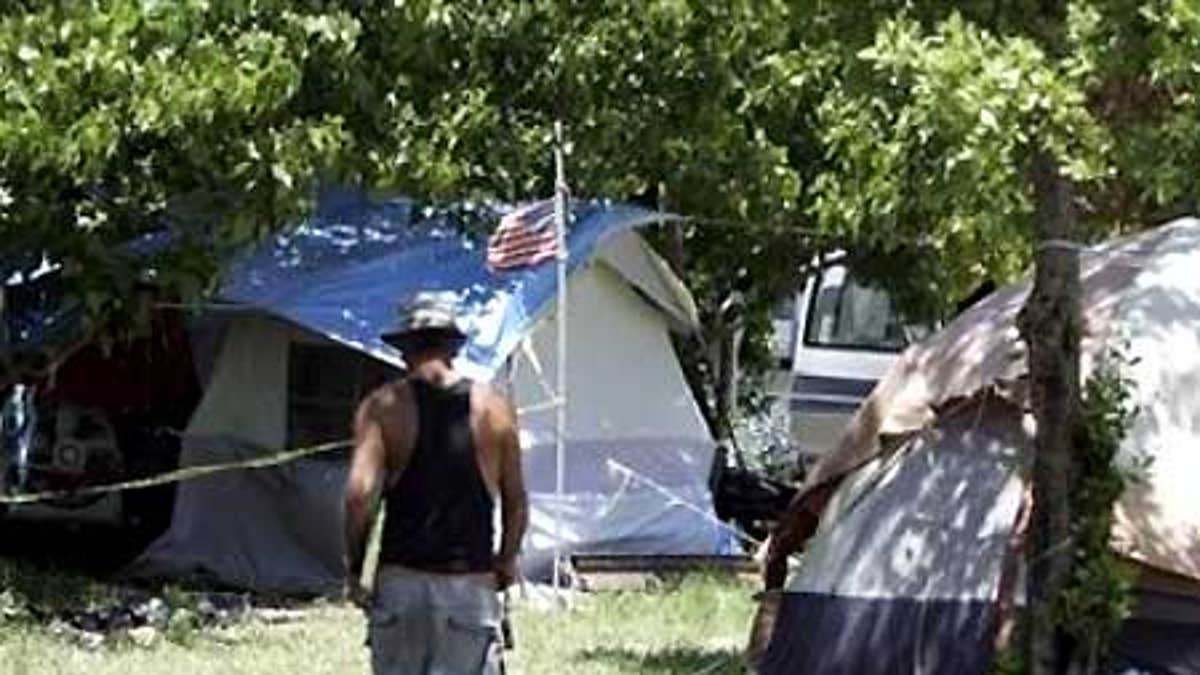
A homeless person walks to a tent under the Julia Tuttle Causeway in Miami. (AP)
When police raided the home of convicted sex offender Phillip Garrido and freed Jaycee Lee Dugard, a girl who'd been kidnapped 18 years earlier, they were astounded to learn that more than 100 other sex offenders lived is the same area.
What they discovered is a trend that has been raising concerns among cops, local officials and experts across the country who study efforts to rein in sex offenders.
It is called clustering -- and it is raising alarms from coast to coast, from Florida to Iowa to California.
As states and municipalities have enacted laws that bar registered sex offenders from living near schools, playgrounds and other places where children congregate, they have been forced to settle down in more remote, often rural, areas where restrictions haven’t been imposed or there is enough space to avoid them.
Experts call that a recipe for disaster that could create far more danger to the public and undo all the work that imposing restrictive living measures for offenders has tried to accomplish.
That certainly was the case when police rescued Dugard, who was abducted in 1991 when she was 11 years old. Garrido, who lived in an unincorporated area near the run-down city of Antioch, Calif., just outside San Francisco, allegedly held her in a warren of tents in his back yard and fathered two children by her.
But Garrido wasn't the only one who was drawn to Antioch. It was the legal void that unincorporated areas provide -- a place where isolation and “a mind-your-own-business” attitude are cherished -- that attracted more than 100 other sex offenders to that one zip code, 94509. And it was that attitude that many say allowed Dugard's captivity to go on for so long.
And Antioch isn’t the only place where such a cluster can happen.
In Iowa, transient hotels outside Des Moines and other cities have largely been taken over by sex offenders who can no longer find legal housing inside the city limits. In addition, there are sex offenders who work and stay in Iowa cities during the day and simply drive out of city limits to sleep in their cars ar night.
In Florida, according to Prof. Jill Levenson, there are more than 100 sex offenders living in a 1-square-mile area of Broward County.
Levenson didn’t name the area, but Broward County has become famous for its inability to find homes for released offenders. Instead it houses them under a bridge on the Julia Tuttle Causeway. The only other location, according to local newspaper reports, is a swampy, isolated trailer park on the far west of the county.
In San Francisco, experts say, sex offenders are making up an ever-growing portion of the homeless population because there is literally nowhere in the city where they can live legally. “One hundred percent of San Francisco’s sex offenders are homeless,” says Robert Coombs of Calcasa, the California Coalition against Sexual Assault, “There is just nowhere they can live in the city.”
There are no national data on clustering. The few cases that are known have usually been found after a crime has been committed, or in the case of the Florida causeway because they were so blatant. This is partly because it is a new trend, and partly because restrictive laws are so new that just keeping up with enforcement has been a problem for police.
There are 674,000 convicted sex offenders in the United States. An estimated 100,000 of them have failed to register. And their sheer numbers are overwhelming police efforts to keep track of them, according to police and experts in the field.
But the prognosis for the future is grim as more and more states, counties and municipalities pass ever stricter sex-offender laws.
“The simple fact is that wherever restrictive laws are enacted, there is a good chance that clustering will occur,” Levenson said.
The irony of the situation is that efforts to rid towns of sex offenders may actually be making the situation worse. Experts say that as more governing bodies pass laws restricting where sexual offenders can live, the more inclined they are to find "cluster" areas where they can legally settle.
“Packing them away from cities means there are fewer treatment options, less oversight and less support,” say Miai Christopher, executive director of the Association for the Treatment of Sexual Abusers. “And stability is the most important element in keeping sex offenders from committing further crimes.”
“In neighborhoods near the clusters,” according to Levenson, “there is increased fear, people feel unsafe and they worry about whether they are more likely to be the victims of an offense.”
“It is not where they aren’t living that is the problem, it is where they are,” says Ernie Allen, president of the National Center for Missing and Exploited Children. “If you put these guys together it will lead to a higher incidence of sex abuse as they talk about this stuff. I see it as a dangerous trend.”
